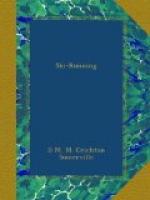Part (a).—A descent of not less than 2,500 feet, which should, if possible, be continuous without any intervening stretches of level or uphill. The course selected must provide ample opportunity for fast, straight running, and must also include a fair proportion of steep and difficult ground.
Part (b).—A descent of not less than 1,000 feet on really difficult snow, such as hard, wind-swept, unbreakable crust, on which Lifted Stemming turns are practicable but Telemarks impossible, varied by breakable crust in which only Jump turns are practicable.
Part (c).—A descent of not less than 500 feet of difficult woodrunning in which continuous turns are just possible for a first-class runner..
The above represents a minimum, rather than a maximum. If Judges can devote sufficient time to the Test, each section may well be repeated on different days in order that the Judges may have ample opportunity of coming to a decision.
For a descent of about 500 feet, the candidate should lead in order to test his capacity for choosing a good line. During the rest of the Test one of the Judges must lead and must set a first-class speed. The other Judge must remain behind the candidate in order to compare his speed and steadiness with that of the leading Judge.
A First Class runner turns as little as possible and slows up as little as possible before each turn. His turns are done at a high speed on all but very steep ground.
The candidate must satisfy the Judges that his running combines high speed, thorough steadiness on difficult ground and difficult snow, and an easy, effortless control of his ski.
SKI-JUMPING TESTS.
GENERAL REGULATIONS.
1. The length of a jump shall be measured with a taut tape from the edge of the take-off to that point at which the hindermost ski touches the alighting track with the part immediately below the binding.
2. To constitute a standing jump the runner must not fall within a distance of 40 metres from the edge of the take-off or within a distance of 60 metres where the jump, as in the First Class Test, exceeds 30 metres. If the runner comes to a standstill without falling within this distance he will be held to have stood.
3. If a runner saves himself from falling by supporting himself with his hands, he shall be considered to have fallen.
THIRD CLASS TEST (JUMPING).
1. Every Candidate is required to make two standing jumps of not less than 10 metres. Four attempts are allowed on the same day.
2. Any two Judges appointed by the Council for the Cross Country Ski-ing Tests are qualified to judge this Test.
SECOND CLASS TEST (JUMPING).
1. Every Candidate is required to make two standing jumps of not less than 20 metres. Four attempts are allowed on any one day.




